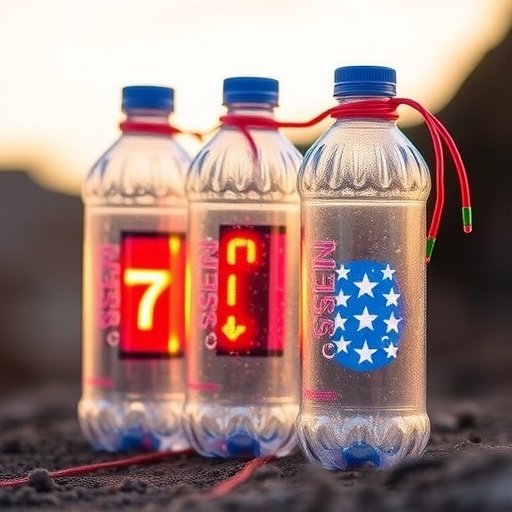In an era when sustainability and environmental preservation are paramount, a groundbreaking advancement has emerged from the realm of materials science. Researchers have pioneered an innovative method to transform discarded single-use water bottles made from poly(ethylene terephthalate) (PET) into high-performance supercapacitor components. Published recently in ACS’ Energy & Fuels, this novel approach ushers in a new frontier where plastic waste transcends its status as pollution to become a cornerstone in next-generation energy storage technologies. This development demonstrates not only the feasibility of upcycling PET but also its potential to outperform traditional materials in critical energy applications.
Globally, PET is one of the most widely used plastics, with over 500 billion single-use beverage bottles produced annually. This mammoth production volume leads to a staggering accumulation of plastic waste, much of which ends up in landfills, exacerbating ecological degradation. The urgency to address this mounting environmental challenge has spurred researchers to rethink PET’s lifecycle, focusing on advanced recycling techniques that can reinvent its value beyond single-use applications. The research team, helmed by Yun Hang Hu, showcases a promising pathway by converting this vast reservoir of plastic waste into functional carbon-based components for supercapacitors.
Supercapacitors are vital energy storage devices, known for their ability to rapidly store and release energy through electrical double-layer capacitance, making them indispensable in a variety of fields such as transportation, consumer electronics, and industrial systems. Unlike batteries, supercapacitors rely on highly conductive carbon electrodes to deliver repeated quick bursts of high power. Key to their performance are the porous carbon electrodes and the separator films that modulate electrolyte flow and electrical isolation within the device. By leveraging PET waste, Hu and colleagues have crafted an all-plastic supercapacitor that rivals, and in some metrics surpasses, devices assembled using conventional glass fiber separators.
The team introduced two distinct heat-based fabrication methods to upcycle PET into supercapacitor components, effectively reimagining waste plastic at the molecular level. First, bottle fragments were finely chopped into couscous-sized grains and mixed with calcium hydroxide before being pyrolyzed at approximately 700 degrees Celsius under vacuum. This thermal treatment induced carbonization of PET, resulting in a porous, electrically conductive carbon powder ideal for supercapacitor electrode fabrication. The carbon powder was subsequently blended with carbon black and a polymer binder to produce uniform, thin electrode sheets through controlled drying.
For the separator film, a different physical transformation was employed. Small pieces of PET, comparable in size to postage stamps, were flattened and meticulously perforated with hot needles. This process created an optimized porous pattern enabling efficient ionic conduction through the electrolyte while preserving electrical insulation between electrodes. The perforated PET separator thus served as a resilient, lightweight alternative to traditional glass fiber membranes, contributing to a fully plastic-based device architecture.
In assembling the supercapacitor, researchers sandwiched two porous carbon electrodes, fabricated from upcycled PET, within a potassium hydroxide electrolyte medium. The perforated PET film was positioned between the electrodes to prevent short circuits while allowing ionic flow. Performance testing revealed that the upcycled supercapacitor retained an impressive 79% of its initial capacitance after cyclic operation. Intriguingly, this retention rate slightly surpassed that of a comparable device incorporating a glass fiber separator, which exhibited a 78% capacitance retention, underscoring the efficacy of the all-plastic design.
The implications of this research extend beyond the laboratory, heralding opportunities for circular energy storage solutions that transform post-consumer plastic waste into valuable, high-performance components. Beyond environmental benefits, the cost efficiency of producing fully plastic supercapacitors is notable. PET-based devices are less expensive than those utilizing glass fiber separators, reducing manufacturing expenses while maintaining recyclability. This confluence of economic and ecological advantages signals a vital step toward sustainable energy storage technologies that align with global efforts to reduce plastic pollution.
Looking forward, the team envisions further optimization of the fabrication processes and material properties to unlock the full potential of PET-derived supercapacitors. Refinements in carbonization parameters, electrode architecture, and separator porosity could elevate device capacitance, cycling stability, and overall energy density. Hu optimistically forecasts that within five to ten years, these upcycled supercapacitors could transition from experimental prototypes to commercially viable energy storage solutions, particularly as demand for sustainable, recyclable technologies escalates worldwide.
The innovative use of calcium hydroxide during pyrolysis is especially noteworthy, as it facilitates the creation of a porous carbon structure essential for effective electrode performance. The porous morphology increases surface area accessible to ions, a critical factor for enhancing charge storage capacity. This strategy exemplifies how chemical additives during thermal conversion can tune the electrochemical characteristics of carbon materials derived from plastic waste, thereby bridging environmental remediation with cutting-edge materials engineering.
The research also underscores the versatility of PET as a precursor material for energy applications beyond its conventional uses. By manipulating its molecular backbone through controlled thermal and chemical processes, PET not only sheds its harmful waste identity but gains functional superiority in energy storage devices. This shift redefines the lifecycle of plastics, emphasizing resource efficiency and circular economy principles within the chemical and materials sciences.
Moreover, the mechanical robustness and recyclability of the perforated PET separator represent a tangible improvement over glass fiber alternatives. Traditional glass fiber separators, while effective, pose challenges in waste handling and cost. The all-plastic separator is not only lighter but also easier to recycle alongside the electrodes, further streamlining end-of-life processing. Such integration of material design and sustainability facilitates more eco-conscious manufacturing of energy devices.
In sum, this pioneering research opens transformative pathways where abundant plastic waste is harnessed to meet burgeoning energy storage needs. The confluence of environmental stewardship, material innovation, and functional performance outlined in this study exemplifies the future trajectory of green energy technologies. As society grapples with plastic pollution and the imperative for sustainable energy systems, PET-derived supercapacitors stand as a beacon of scientific ingenuity and hope.
Subject of Research: Upcycling poly(ethylene terephthalate) (PET) waste into supercapacitor components
Article Title: “All-Plastic Supercapacitors from Poly(ethylene terephthalate) Waste”
News Publication Date: 7-Sep-2025
Web References: http://dx.doi.org/10.1021/acs.energyfuels.5c03370
Keywords: Chemistry, Recycling, Energy




